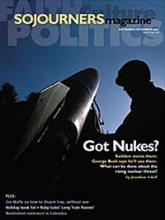When this book was published, the Committee to Protect Journalists had just named the West Bank as "the worst place to be a journalist." Two photojournalists have been killed by the Israeli Defense Forces (IDF) this year, and many others have been injured.
The antagonism between the press and the IDF was obvious during my trip in June to the West Bank town of Bethlehem, on an abortive outing with a Swedish Reuters photographer featured in the book (he lives in the West Bank and is married to a Palestinian). Helmeted and flak-jacketed, we spent most of the time scurrying through Palestinian backyards to avoid patrols, paradoxically looking for "action" while avoiding the attention of those perpetrating it.
One journalist in the book writes about the Syrian head of state that he believes ordered his assassination. Another writes of a suicide bombing at his child's school. With examples like these, I generally regard the notion of an unbiased press as a myth. None of us can shed our contexts and perspectives and conjure the "unbiased insight" that this book's dust jacket touts. Like preachers, reporters are often at their best when they tell stories instead of "truth."
Read the Full Article
